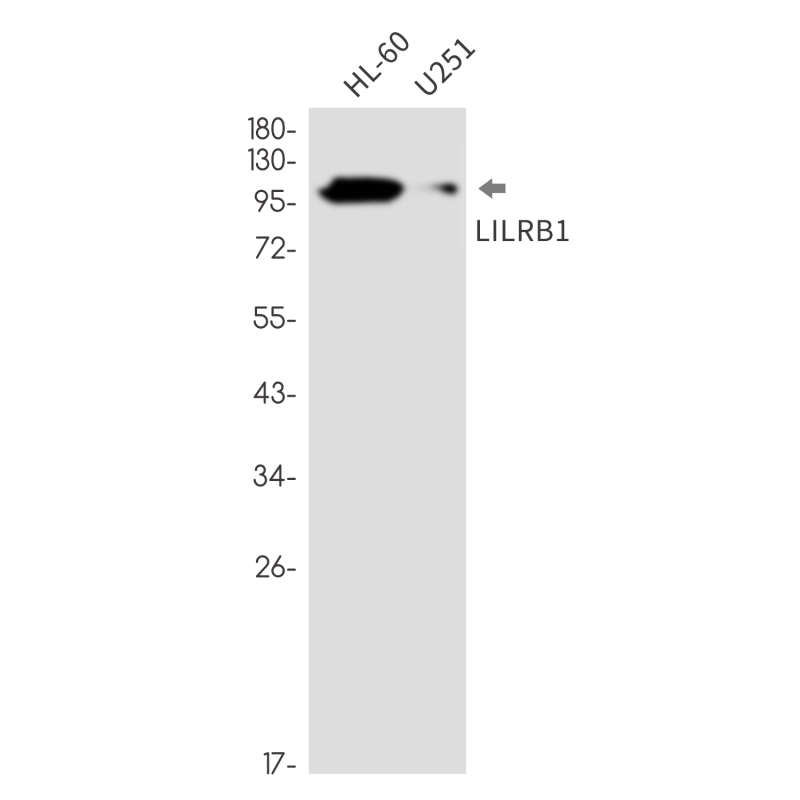
| WB | 1/500-1/1000 | Human,Mouse,Rat |
| IF | 1/20 | Human,Mouse,Rat |
| IHC | 咨询技术 | Human,Mouse,Rat |
| ICC | 技术咨询 | Human,Mouse,Rat |
| FCM | 咨询技术 | Human,Mouse,Rat |
| Elisa | 咨询技术 | Human,Mouse,Rat |
| Aliases | ILT2; LIR1; MIR7; PIRB; CD85J; ILT-2; LIR-1; MIR-7; PIR-B |
| Entrez GeneID | 10859 |
| WB Predicted band size | Calculated MW: 71 kDa; Observed MW: 110 kDa |
| Host/Isotype | Rabbit IgG |
| Antibody Type | Primary antibody |
| Storage | Store at 4°C short term. Aliquot and store at -20°C long term. Avoid freeze/thaw cycles. |
| Species Reactivity | Human |
| Immunogen | Recombinant protein of human LILRB1 |
| Formulation | Purified antibody in TBS with 0.05% sodium azide,0.05%BSA and 50% glycerol. |
+ +
以下是3篇关于LILRB1抗体的代表性文献,按研究方向和摘要内容分类整理:
---
1. **文献名称**:*"Blockade of the CD85j (ILT-2/LILRB1) receptor enhances human NK cell functions"*
**作者**:Saveria et al.
**摘要**:研究证明,使用抗LILRB1单克隆抗体阻断该受体可增强自然杀伤(NK)细胞的细胞毒性,并促进其对肿瘤细胞的杀伤能力,提示其在癌症免疫治疗中的潜在应用。
---
2. **文献名称**:*"LILRB1-mediated inhibition of T-cell activation via CD47 ligation in human cancers"*
**作者**:Liu et al.
**摘要**:揭示了LILRB1通过与肿瘤细胞表面CD47结合抑制T细胞功能,并开发了一种靶向LILRB1的抗体,可逆转免疫抑制微环境,增强抗肿瘤免疫应答。
---
3. **文献名称**:*"Antibody targeting of LILRB1 reshapes myeloid cell activity to enhance anti-PD-1 therapy"*
**作者**:Barkal et al.
**摘要**:通过临床前模型验证,抗LILRB1抗体可重编程髓系细胞的免疫功能,并与PD-1抑制剂协同作用,显著提升实体瘤治疗效果,为联合免疫治疗提供新策略。
---
**研究方向拓展**:
LILRB1抗体研究多聚焦于解除其对免疫细胞的抑制(如NK细胞、T细胞、巨噬细胞),尤其在肿瘤免疫治疗中,常与PD-1/PD-L1等检查点抑制剂联用。部分研究还涉及自身免疫病或炎症调控。近年研究趋势包括双特异性抗体开发及机制深挖(如与HLA-G等配体的相互作用)。
LILRB1 (leukocyte immunoglobulin-like receptor B1), also known as CD85j or ILT2. is an inhibitory immune checkpoint receptor belonging to the immunoglobulin superfamily. Expressed on various immune cells, including NK cells, T cells, B cells, and myeloid cells, LILRB1 contains immunoreceptor tyrosine-based inhibitory motifs (ITIMs) that suppress immune activation upon binding to MHC class I molecules (HLA-A, -B, -C, -G). This interaction plays a critical role in maintaining immune tolerance and dampening excessive immune responses, particularly in contexts like pregnancy, transplantation, and tumor evasion.
In cancer, LILRB1 engagement by tumor-associated MHC-I molecules contributes to immune evasion by inhibiting cytotoxic lymphocyte activity and promoting immunosuppressive phenotypes in myeloid cells. Consequently, LILRB1 antibodies designed to block this interaction have emerged as promising therapeutic tools to counteract immune suppression in the tumor microenvironment. Preclinical studies show that anti-LILRB1 antibodies enhance anti-tumor immunity by restoring NK and T cell function or reprogramming macrophages toward a pro-inflammatory state.
Beyond oncology, LILRB1-targeting antibodies are explored in infectious diseases (e.g., HIV immune escape) and autoimmune disorders. Challenges remain in optimizing specificity, avoiding off-target effects, and understanding context-dependent receptor functions. Current research focuses on bispecific antibodies, combination therapies, and biomarker-driven strategies to maximize clinical efficacy.
×